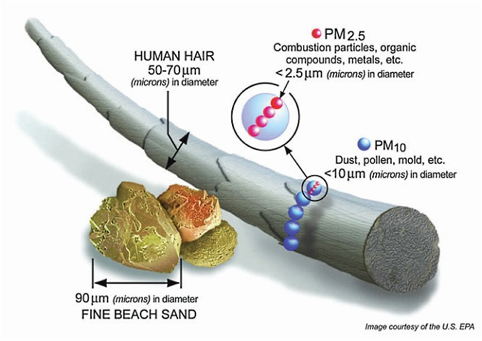
Particulate matter (PM) is made of solid particles and liquid droplets in the air. PM can come from many places. In general, any type of burning or any dust-generating activities are sources of PM. Here are some examples:
- Emissions (from vehicles and industrial plant smokestacks),
- Burning wood, such as in open burning, fireplaces, and residential wood-burning boilers or stoves, and
- Swirls of dirt that form when the wind blows.
PM comes in many different sizes. Larger particles come mostly from the soil. Smaller particles come from the burning of fossil fuels, like gasoline in cars, diesel in trucks, and coal used by power plants.
EPA regulates two sizes of PM, PM 10 and PM 2.5. PM 10 includes particles 10 micrometers in diameter and smaller. PM 2.5, also called fine particles, includes particles 2.5 micrometers in diameter and smaller.
PM is also divided into primary and secondary categories. Primary PM is directly emitted from a smokestack or a tailpipe. Secondary PM forms downwind from sources of gaseous emissions through chemical reactions.
Learn more about particulate matter via the following links:
- How to Reduce Particulate Matter
- Effects on Health, Environment
- Ozone, Particulate Matter Data
- Particulate Matter News
Contact: Mary Peyton Wall, Manager, (803) 898-4064

